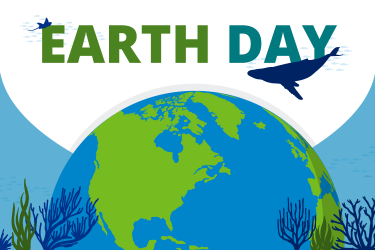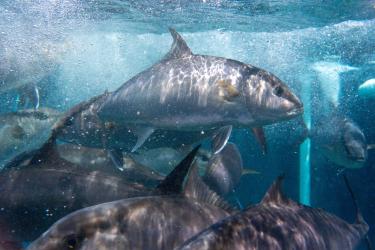Is there a better way to celebrate Valentine’s Day than with a hearty bowl of fresh seafood? With our strict environmental protections, all seafood produced in the United States—wild-caught and farmed—is a sustainable choice.
But if you ask our team, they’d tell you that there’s something special about American-farmed seafood. From savory shellfish and crunchy kelp, to unbelievably fresh fish, aquaculture has something for everyone!
Here are some ways that our experts show their love for farmed seafood.
Sharing Seafood Around the Dinner Table
Danielle Blacklock, Director of the Office of Aquaculture, leads NOAA’s vision for a thriving, resilient, and inclusive U.S. aquaculture industry. It provides jobs, expands access to domestic seafood, and reinforces healthy oceans. And for the Blacklock family, that mission starts at home. Good food brings people together. Gathering around a table is an opportunity to share family traditions, culture, and ideas—in addition to a meal.
“With two toddlers at home, my husband and I cook a lot of seafood as a quick, healthy option,” said Blacklock. “We eat farmed salmon regularly in my house. I love using a sturdy cast iron skillet on the stove and then finishing it off under the broiler—that way I don’t have to flip anything!” When it is cold outside, she is also known for her New England clam chowder, but her kids favorite remains fish sticks!
Cooking is an Act of Love
For Gabriela McMurtry, policy analyst, cooking sustainably farmed seafood is a tangible act of love. It requires thoughtfulness, creativity, and persistence to prepare a meal. “Cooking for loved ones, whether it’s for family, friends, cats, or myself (self care is an important expression of love!) cooking a meal is my favorite way to express love and appreciation for the people I care about,” said McMurtry.
While Gabriela grew up eating seafood, it wasn’t until she joined NOAA Fisheries that she realized the world was her oyster. “Not only is there an abundance of farmed seafood choices, there’s a million ways to cook them all,” said McMurtry. Working in aquaculture has inspired her to try new kinds of recipes. Her latest culinary feat was fish tacos, and next on the agenda is fisherman's pie. This Valentines Day, she encourages you to cook for the people you love.
A Fourth-Generation Oyster Shucker
A fourth-generation Washingtonian, Teri King is NOAA’s Regional Aquaculture Coordinator for Washington and Oregon. She gathers oysters and digs for clams and geoduck as an every low tide event to supplement her family’s meals. “ My mom had us on the beach at a young age to learn how to find and properly harvest shellfish. I remember being on the beach at 3 years old and using a butter knife to try to open an oyster. It would take me a long time to pry the delectable goodness out of the shell. Nowadays I wield an oyster knife and make short work of my harvest limit.”
Teri worked at the University of Washington School of Fisheries on oyster aquaculture projects. She had a chance to shuck a few hundred oysters a day for the various research projects in the Dr. Ken Chew lab. That lab and its amazing scientists helped the shellfish aquaculture industry on the West Coast thrive by providing critical information and technology, such as the triploid oyster. Much of the science for the shellfish products produced along the West Coast and shipped around the world are a tribute to the innovation of the Chew lab and the ingenuity of the West Coast shellfish industry to create amazing products.
Celebrating with Farmed Shellfish
Brianna Shaughnessy grew up on Cape Cod where farmed shellfish reigns. So oysters, clams, and scallops are symbols of home for her, conjuring fond memories of gatherings with loved ones. Shellfish represent the hard labor of the working waterfronts that raised and inspire her. So, naturally, after Brianna defended her Ph.D. thesis, she went straight to a local sustainable seafood restaurant, Row34, to celebrate with a shellfish tower!
“When I’m cooking at home, I like to sear local scallops with butter, garlic, lemon, and white wine. Although I usually purchase my scallops off of day boats, many people are unaware of the important role that aquaculture plays in supporting the New England scallop industry,” said Shaughnessy. Additionally, aquaculture hatcheries in the region spawn millions of tiny bay scallops and release them to “seed” native habitat. This practice supplements wild populations and keeps stocks viable. It makes a great example of aquaculture and wild-capture fisheries communities partnering for sustainable management.
Experimenting with Seaweed
In his role as an Alaska Sea Grant Fellow with the NOAA Fisheries Alaska Aquaculture Program, James Currie has enjoyed learning about (and sampling) the unique delicacies of Alaskan aquaculture. Some of his work has included leading science communication projects, performing stakeholder engagement in coastal Alaskan communities, and visiting local aquaculture companies to learn about the industry.
“It’s been a great experience, living in Juneau, to see so many local aquaculture companies represented in Alaskan shops. And the quality of their products is astounding,” said Currie. “Growing up on the coast of Maine, I have always been interested in seaweed—how it moves, how it shelters animals, how it contours the beach like an underwater forest. But I didn’t have any idea how useful it could be for cooking.” James also uses a variety of local seaweed products in his regular cooking at home. One of the most useful ingredients is kelp salsa. He has also started experimenting with using seaweed in baking, leading to his most recent discovery: sugar kelp focaccia!
Returning to New England Seafood Roots
Growing up in Massachusetts, Kristen Jabanoski remembers frequently eating locally caught fish and other seafood as a child. Her family broke out the lobster pot on special occasions. Her grandfather was an artist who often painted New England scenes including fishermen and working waterfronts. As a teenager, she adopted a vegetarian diet and didn’t explore cooking and eating seafood until nearly a decade later when she took a job at NOAA.
Kristen works at the NOAA Fisheries Milford Lab in Connecticut as a science communications specialist. This lab is a leader in shellfish research and has a long history of working with the shellfish aquaculture industry. "I embraced the sustainability and health benefits of local shellfish after visiting farms, meeting growers and communicating about the lab's research," Jabanoski explained, "Now I particularly enjoy cooking with local oysters and clams, like Oysters Rockefeller and clam linguini.”








